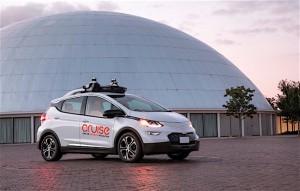
Cruise Automation introduced its third-gen automated vehicle. The new vehicles will be part of its San Francisco-based test fleet.
General Motors is putting its money where its mouth is when it comes to being a leader in autonomous vehicle technology, announcing today it was acquiring Lidar technology company Strobe Inc.
Strobe, based in Pasadena, California, will be taken under the wing of GM’s Cruise Automation team to develop next-generation Lidar for the company’s self-driving vehicles. The parties did not reveal the financials of the agreement.
The company’s developed a new microchip Lidar system would significantly enhance the capabilities of the self-driving cars GM was developing, Vogt said during conference call with reporters.
Reducing the entire sensor down to a single chip, the system cuts the cost on its self-driving cars by 99%, he said. The technology provided not just a distance measurement for an object on the road – vehicles, people and objects – but also measured that object’s velocity.
(GM, Cruise release third-gen robot car. For details, Click Here.)
“Strobe’s LIDAR technology will significantly improve the cost and capabilities of our vehicles so that we can more quickly accomplish our mission to deploy driverless vehicles at scale,” said Kyle Vogt, founder and CEO, Cruise Automation.
GM purchased Cruise Automaker for $1 billion last year and then basically turned over the keys to its automated vehicle development to the San Francisco-company. Earlier this year, GM said it planned to spend $600 million in 2017 on self-driving vehicles. That number may apply to 2018 too.
Lidar is what an autonomous vehicle uses to “see” when it’s on the road. It uses light to create high-resolution images that provide a more accurate view of the world than cameras or radar alone. As self-driving technology continues to evolve, Lidar’s accuracy will play a critical role in its deployment.
“The successful deployment of self-driving vehicles will be highly dependent on the availability of Lidar sensors,” said Julie Schoenfeld, founder and CEO, Strobe, Inc. “Strobe’s deep engineering talent and technology backed by numerous patents will play a significant role in helping GM and Cruise bring these vehicles to market sooner than many think.”
Last month, Cruise Automation revealed the world’s first mass-producible car designed with the redundancy and safety requirements necessary to operate without a driver. The vehicle will join Cruise’s testing fleets in San Francisco, metropolitan Phoenix and Detroit.
(Click Here for details about GM investing in autonomous driving software company.)
The company announced yesterday it plans to launch its first semi-autonomous system, the Cadillac Super Drive, in the 2018 Cadillac CT6. GM’s first fully self-driving car coming to market will be a version of the electric Chevrolet Bolt EV, GM’s CFO Chuck Stevens announced this spring.
The race is heating up at other automakers are looking to be first to finish line with a completely autonomous vehicle. Tesla, Daimler and others are working to make self-driving vehicles a reality. A Navigant Research report this spring put Ford at the top of the autonomous vehicle lead.
Cruise recently passed another milestone of sorts with the introduction of its third generation of fully autonomous factory-built test vehicles.
(GM investing $14 million in Cruise Automation. For the story, Click Here.)
Vogt described the third-generation vehicle as “the world’s first mass-producible car designed to operate without a driver. This isn’t just a concept design, it’s assembled in a high-volume assembly plant in Orion Township, Michigan, out of Detroit capable of producing 100,000’s of vehicles per year,” he said.
